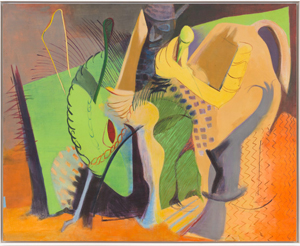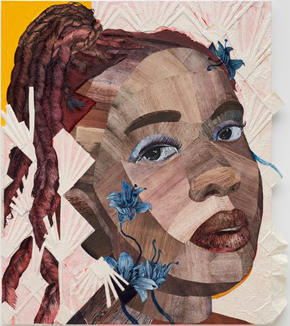Reversing the Diaspora
John Haberin New York City
Vivian Browne, Tunji Adeniyi-Jones, and Yashua Klos
Vivian Browne was that marvel, a lifelong learner, and it informed her art. She was past forty when she came to Nigeria, only in part to study at the University of Ibadan. She was in search of her heritage, her art, and herself.
She found them in abstract painting. So back then did no end of white artists, but it shows just how capacious her heritage and that of modern art are. A generation later, African American artists may take for granted a need to assert pride in their heritage—but which heritage? Tunji Adeniyi-Jones recreates Browne's two-way journey to Africa and back, and who can say which has a greater urgency? When Yashua Klos tries to reconcile family and factory labor, is it necessarily a struggle? The movement toward a greater diversity insists on their roots in Africa and their place in Western art. 
Voyage of discovery
Vivian Browne continued her travels for two more years after her studies in Nigeria, and she was amply rewarded. She found time for over a hundred paintings between 1971 and 1974. A gallery can offer only a selection. They took her in a wholly new direction—only not the one you might expect. They brought her closer to abstraction. She has been known for that ever since, and one can see it emerging in paintings and works on paper.
Nor is it her image alone. Increasingly, exhibitions have focused on identity politics in black abstraction, with such artists as Sam Gilliam and Melvin Edwards. Their taking abstraction off the wall and into the lives of those who see it is at the heart of the 2022 Whitney Biennial, for artists black and white. Eugene J. Martin found a route toward nonfigurative painting in collage and figure studies of the black community, for what he called "satirical abstraction." For them all, abstract and political art are not mutually exclusive, no more than satire and celebration. Browne would have to agree.
"Black art," she said right out, "is political." She was claiming African American for politics—and claiming cutting-edge art and Western tradition for herself. Formalism still ruled in the early 1970s, so why should it exclude her? She grew up in New York, and she had the sophistication to ask. One can see her travels as giving her the confidence to proceed. Yet Africa also opened her, like Onyeka Igwe, to feelings and surroundings that she could express in no other way.
Browne has had a limited presence in New York, although she has entered her share of museum collections, and she is new to me. It takes time to get to know what one cannot pin down, and who could pin down abstraction like this? Colors melt into one another, tart yellows and greens along with earthier browns and fiery red. Grid-like patterns emerge from color fields and colored shapes, only to cover them and then to break off. Just listen, though, to the titles—Shango Kingdom, Benin Beauty, Assistant to the Chief, and Umbrella Plant. This, they say, is a living and breathing native tradition.
She got to know it by always observing and always connecting what she saw. (Those skills must have come in handy in later years as a teacher and department head in Newark.) That range of colors looks thoroughly observed, right down to the startling gradations from brown to red. Etchings take on the roughness of first sketches, drawings the polish of posters and prints, and both testify to her experience. Abstraction contributes, though, in another way as well, long after one sees the realism: it allows Browne's fluid subjects to slip away.
That attendant might be a red crescent moon, the umbrella plant part of a river crossing and a human hand. The Gathering comes down to just two people, coming together in war or peace, Diversities a single person in a landscape. Bathers stand erect, without the innocence and idealism of Henri Matisse. Strokes seemingly carved into their skin could belong to a totem, a present-day African, or the modernist unfinish of Paul Cézanne. A cursory view can make her work look purely abstract. Nearly thirty years past her death in 1993, nothing seems as pure.
Learning from stereotypes
When Tunji Adeniyi-Jones looks to Africa, it brings him closer to a century of Western art. It also takes him to two media and two bodies of work. Do they present a single impulse? At first, they could be polar opposites—and I am tempted to say male and female. But then the Nigerian artist makes a point of learning afresh from stereotypes. At the very least, he is reversing the diaspora.
Both media are reasonably Western and contemporary, and (speaking of polar opposites) they start in black and white. Like Georg Baselitz, to name just one, Adeniyi-Jones turns to lithographs for the broad, coarse outlines of far earlier woodcuts. They recall African sculpture as well, all the more so as the silhouettes collide as actual totems never will. His other medium, oil on canvas, has a room to itself, to keep it apart. Here the figures are more rounded, especially their bellies, and the collisions are closer to nesting. The space is more crowded and the action more stable.
The brushwork is creamier than lithography's grease on stone, and the colors add up to an orange red, like cruder, brighter flesh tones. Could the two series stand for male and female, stern and nurturing? They differ, too, as night and day, and the prints are his Midnight Voices. Adeniyi-Jones sees sources for his silhouettes in Aaron Douglas of the Harlem Renaissance, where, as Winold Reiss discovered, the real action was often at night. He also cites Ben Enwonwu, a Nigerian painter who died in 1994. Enwonwu focused on past symbolic form and female figures.
Adeniyi-Jones, though, does not. He describes his silhouettes as androgynous, and on second look they are. It takes a biased violence to read more into them, and which is not to say that he is complaining if you do. For all the clashing and upright postures of totems and goddesses, they are also dancing or floating free. The fragmented space derives from another side of modern art as well, Cubism. Just be aware that modern art's use of African art, while dignifying and liberating, came with biases of its own regarding "the primitive."
Born in London, he has every claim to two traditions. Settling in Nigeria may have helped him discover both, much as Africa helped Browne discover her place in abstraction. He also reverses the direction of recent black history. Attention to the Afro-Caribbean diaspora has helped shake things up, as for Renée Stout, as part of the movement toward diversity in art as its "Inheritance." It has inspired memories of lands left behind, but also political art in the present tense, much as for Dawn Williams Boyd. Adeniyi-Jones, in contrast, might seem free to find his own way.
Still, his black history does not run solely in one direction, in time or space. It takes him to Harlem, much as Enwonwu looked back to the Negritude movement of the 1930s. Cubism for him looks alive and well. For now, the polar opposites look equally appealing. He calls his show "Emergent Properties," with the implication that the whole is more than its parts. That includes both color and black and white. Either series by itself can contribute only so much, and he has experimented as well with monotypes, a free-form kind of printmaking. At age thirty, he has time to get things wrong or right.
The roots of struggle
Yashua Klos is coming to terms with his roots. It is connecting him to family history that he had taken for granted as lost. It is reconnecting him to home in Detroit and to modern art, and it is awakening him to Central Africa and its art as well. When he calls his show "Our Labor," you can feel the pleasure he takes in that collective our.  A single work at its center encompasses all those histories, and everyone in it seems to share his pleasure. The surprise is in just how much that coming to terms was a struggle.
A single work at its center encompasses all those histories, and everyone in it seems to share his pleasure. The surprise is in just how much that coming to terms was a struggle.
That one work is a mural, and anyone who loves the Detroit Institute of Arts as he does will know something about murals and struggles. Its collection includes the Detroit Industry murals by Diego Rivera, who left no doubt which side he was on. The Mexican muralist (and husband to Frida Kahlo) studied with Thomas Hart Benton and worked on behalf of the New Deal, so you may expect a celebration of factory labor as heroic and fulfilled. Sure enough, his figures lean at full length into and apart from their work, with Benton's rounded limbs and no end of machinery. Still, its detail leaves nowhere to stand past the very foreground of Rivera's layered space, and distant fires place its welders in a private hell. A predominance of black, cooler colors, and symmetry cramps their style as well.
Klos does not shy away from the competition, with a quaint spelling of Labour that itself belongs to the past. His mural looks all the larger for running the length of the gallery's central wall. Still, here the scene of labor is a pleasure, all the more so for foregoing work. A worker holds a close copy of Rivera's steam engine in her arms, like a child or a bouquet. Others occupy a row like an assembly line, but seated for a party, with balloons. Each incident has ample room for itself, without forced, synchronized motion. Softer edges than Rivera's and a restriction to black and white bring out the casual side of looking, acting, and painting.
These men and women are family and friends, as are large portraits to either side. Their faces in close-up show pride and anger, while a last painting shows only a fist, but then these are solo portraits, and they seem more than friendly enough. A patchwork of colors and torn paper in relief look back to Cubism, but also to African masks. You may not penetrate them any more than a mask, but you can get to know them, slapdash and alive. You might never guess how much getting to know them was for Klos a struggle.
He speaks of Detroit as a destination—not just for work at Ford, but in the Great Migration and the flight from the American South. He devotes much of the gallery handout, though, to his reconnecting with his father, who had abandoned family. He does not paint his father, and one cannot know the strength of the connection, but he sounds satisfied enough for now. He also sculpts his own African masks or masks for welding, although they look more like further machinery or consumer goods than faces. He exposes their charred wood, similar to the patchwork of his portraits. And, they, too, have come to to the party.
Their blond wood cannot glow, but their backdrop does in the gallery's front hall. Decorative tracery covers pitch-black wallpaper, reflecting the lighting and, in the process, acquiring color. The reflection changes as one moves past, and colors shift about halfway down. Once one encounters the mural, it is hard anyway to look back. Klos is young and still coming to terms with his family, heritage, and art. He can only grow, but for now one can respect his struggle—and how well he keeps the struggle in check.

Vivian Browne ran at Ryan Lee through July 1, 2022, Tunji Adeniyi-Jones at Nicelle Beauchene through November 23, and Yashua Klos at Sikkema Jenkins through December 3.




